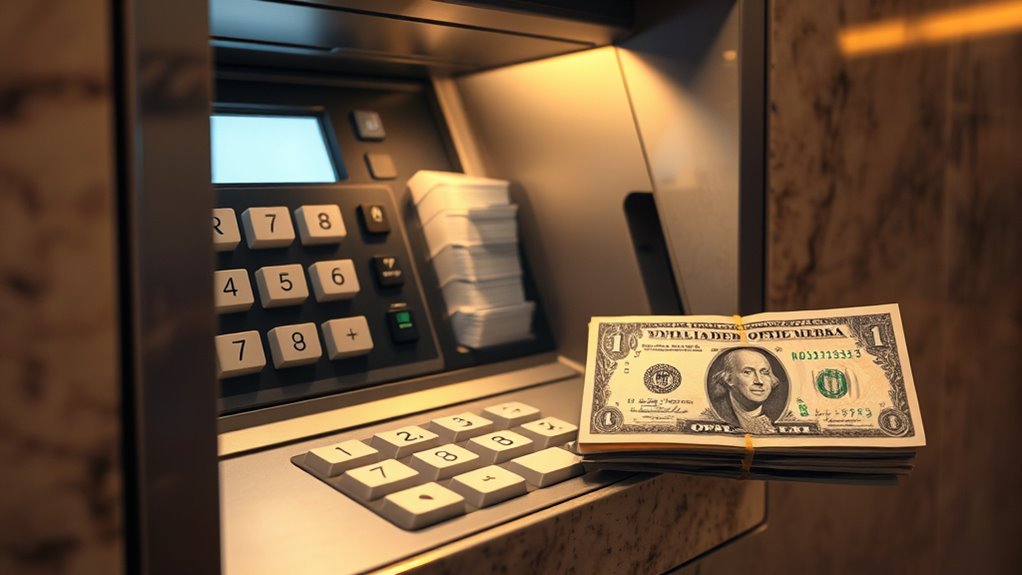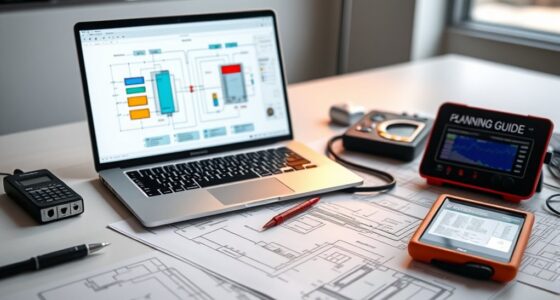Managing your cash on hand and understanding ATM use are key to staying financially secure. Keep track of your cash reserves by recording every transaction, and store extra cash safely for emergencies. Use your bank’s ATMs to avoid fees, watch out for skimming devices, and protect your PIN. Know when cash is better than digital payments for privacy or fees. If you want practical tips on handling cash safely and efficiently, keep exploring this guide.
Key Takeaways
- Maintain an adequate cash reserve for daily expenses, emergencies, and irregular income periods.
- Regularly track all cash transactions and review cash flow patterns to prevent shortages.
- Use secure, well-lit ATMs; cover your PIN and check for tampering before withdrawal.
- Opt for bank-affiliated or fee-free ATMs; withdraw full amounts to minimize fees and trips.
- Store cash securely in discreet locations, limit home cash holdings, and follow best safety practices.
Understanding Cash on Hand: What It Means for You
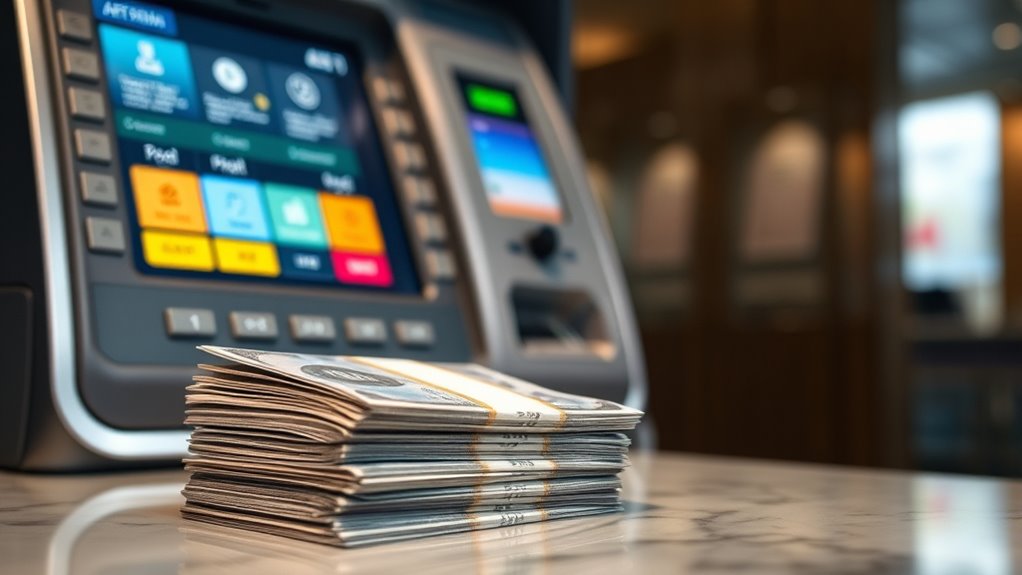
Understanding cash on hand is crucial because it directly impacts your daily financial stability. When you know how much cash you have readily available, you can better manage your cash flow and make informed decisions. Having sufficient cash on hand helps you cover immediate expenses and unexpected costs without relying on credit or loans. It also plays an essential role in your overall financial planning, allowing you to set aside funds for future goals or emergencies. Tracking this cash ensures you’re not overspending and keeps your financial picture clear. Additionally, staying aware of your cash on hand can improve your ability to manage financial risks effectively. By maintaining an accurate understanding of your cash on hand, you can avoid cash shortages and ensure smooth financial operations. This awareness empowers you to stay in control of your money, both today and in the long run.
How to Keep Track of Your Cash Reserves
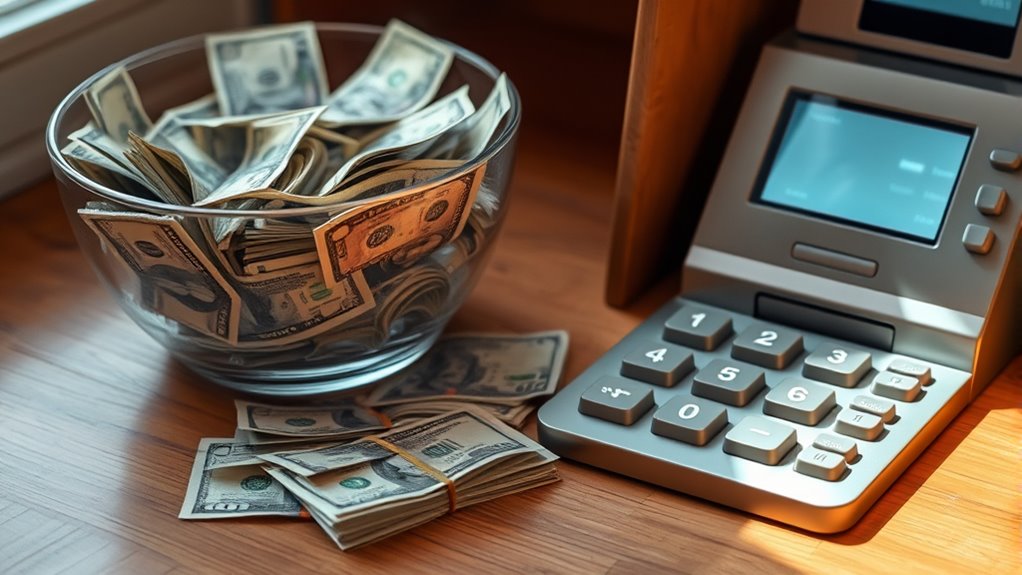
Keeping track of your cash reserves is essential for maintaining financial stability and avoiding surprise shortages. Proper monitoring helps you manage cash flow and stay aligned with your budgeting strategies. To do this effectively, consider these steps:
Monitoring your cash reserves ensures financial stability and keeps your budget on track.
- Regularly record all cash transactions, including small expenses.
- Use a simple ledger or mobile app to log cash on hand daily.
- Set aside a specific amount for emergencies and track its growth.
- Review your cash reserves weekly to ensure they match your budget goals.
- Pay attention to cash flow patterns to anticipate future needs and prevent shortfalls.
The Different Types of ATMs and How They Work
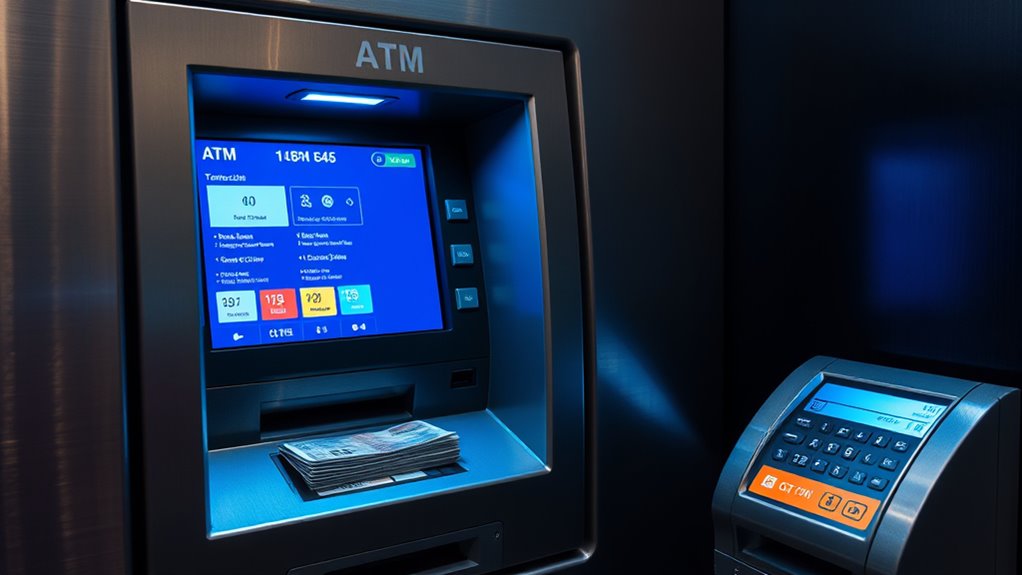
Automated Teller Machines (ATMs) come in various types, each designed to serve different needs and locations. The main ATM types include traditional bank ATMs, off-site ATMs, and drive-up ATMs. Traditional bank ATMs are usually found inside bank branches, offering full services like cash dispensing, deposits, and account management. Off-site ATMs are positioned in convenience stores, malls, or public spaces, primarily focused on cash dispensing and balance inquiries. Drive-up ATMs allow you to perform transactions from your vehicle, often used for quick cash withdrawals. All these ATM types rely on secure systems to process your requests swiftly. Cash dispensing remains the core function across most ATM types, providing quick access to cash whenever you need it, no matter where you are. Additionally, modern ATMs often incorporate advanced security features to protect users’ financial information and prevent fraud.
Tips for Withdrawing Cash Safely and Efficiently

To withdraw cash safely and efficiently, use ATMs wisely by choosing well-lit, secure locations. Be cautious of skimming devices that can steal your card information, and always check for any suspicious attachments before inserting your card. Limiting your withdrawal amounts helps protect your funds and reduces risk in case of theft. Additionally, being aware of card security practices can further safeguard your financial transactions.
Use ATMs Wisely
Using ATMs wisely can help you withdraw cash safely and avoid unnecessary fees. To maximize your efficiency and security, keep these tips in mind:
- Always choose ATMs from your bank to avoid extra charges.
- Plan your cash needs ahead, using cash budgeting to determine how much to withdraw.
- Limit withdrawals to reduce trips, and consider coin collection for small purchases.
- Be aware of your surroundings and cover the keypad while entering your PIN.
- Select machines with well-maintained and secure hardware to minimize the risk of skimming or tampering.
Avoid Skimming Devices
Since skimming devices can be discreetly attached to ATMs, maintaining vigilance whenever you withdraw cash is essential. Before inserting your card, inspect the ATM for any unusual attachments or loose parts. Cover the keypad when entering your PIN to prevent hidden cameras from capturing it. If the machine seems suspicious, avoid using it and report it to bank authorities. When you get your cash, count it immediately to verify the amount and check for counterfeit bills. Handling cash carefully helps prevent accepting fake currency and reduces the risk of theft. Additionally, being aware of ATM security features can further protect you during transactions. Always be alert to your surroundings and trust your instincts. Taking these precautions guarantees your withdrawal process remains safe, minimizing the chances of falling victim to skimming devices and counterfeit bills.
Limit Withdrawal Amounts
Keeping an eye out for skimming devices is a vital step in staying safe at ATMs, but it’s also wise to contemplate how much cash you withdraw each time. Knowing your bank’s cash limits and withdrawal restrictions helps you manage your money better and reduces risks. Here are four tips:
- Set a secure withdrawal amount that fits your daily needs.
- Be aware of your bank’s withdrawal restrictions for larger sums.
- Avoid withdrawing large amounts in unfamiliar or unsecured locations.
- Use ATMs inside banks or well-lit, busy areas to minimize theft risk.
- Familiarize yourself with cash management strategies to optimize your withdrawals and protect your funds.
Avoiding Common ATM Fees and Charges

Avoiding common ATM fees and charges can save you a significant amount of money over time. To do this, always use your bank’s ATMs, which typically don’t charge withdrawal fees. If you need to make a cash donation, plan ahead to withdraw the full amount at once, reducing multiple trips and fees. Be cautious with coin counting machines at some ATMs, as they may charge extra or have limited availability. Check if your bank offers fee-free ATM access through partnerships or networks. Also, avoid using out-of-network ATMs unless necessary. Staying aware of these costs helps you keep more cash on hand, and reduces unnecessary expenses that can add up over time. Additionally, understanding ATM fee structures can help you make smarter choices when accessing cash.
Using Debit and Credit Cards as Alternatives to Cash

Using debit and credit cards can simplify your finances and help you avoid many ATM fees altogether. They are convenient tools for cash budgeting and reduce the need to carry coins for small transactions. Here’s how you can make the most of them:
- Use your card for daily expenses to track spending and stay within your budget.
- Opt for contactless payments to speed up transactions and minimize handling cash or coins.
- Keep a digital record of your purchases to monitor cash flow and avoid surprise charges.
- Limit cash withdrawals to emergencies, reducing the temptation to carry coins or large cash amounts.
- Be aware of cookie categories that websites use to personalize ads and improve user experience, which can influence your online shopping behavior.
Switching to cards can streamline your finances, lessen coin collection, and help you better manage your cash on hand.
Recognizing and Preventing ATM Skimming and Fraud
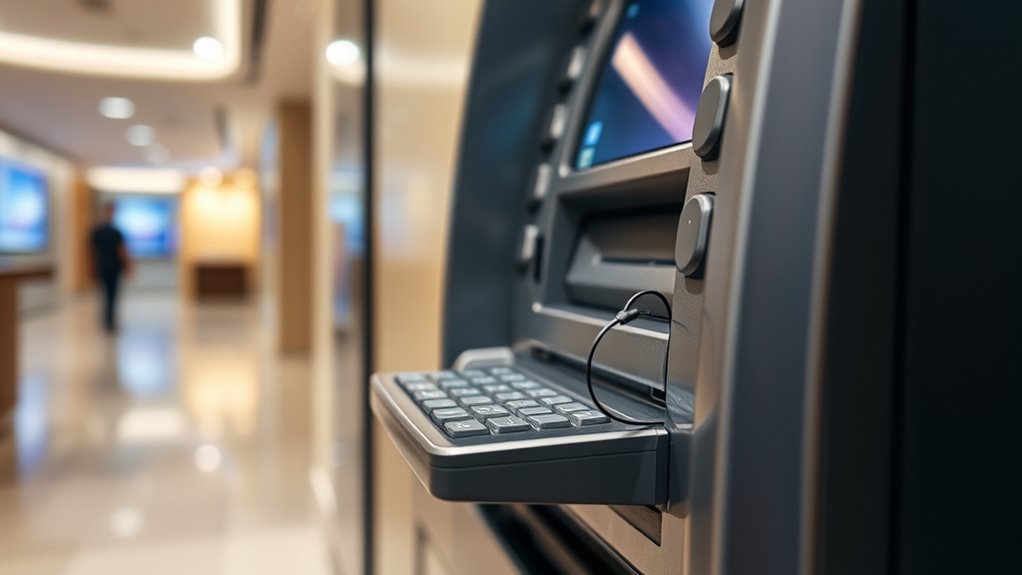
ATM skimming and fraud pose significant risks to your finances, especially as criminals develop more sophisticated methods to steal card information. To protect yourself, stay vigilant when handling ATMs. Always inspect the card reader and keypad for signs of tampering, such as loose parts or unusual attachments. Cover your PIN as you enter it and avoid ATMs in isolated or poorly lit areas. Use fraud prevention tools like secure banking apps and alerts to monitor transactions. Additionally, understanding the importance of affiliate disclosure can help you recognize the potential for third-party vendors to impact your financial security. Here’s a quick guide:
| Tip | Warning Signs | Action to Take |
|---|---|---|
| Inspect ATM carefully | Loose or damaged card slot | Report suspicious activity |
| Cover PIN during entry | Unusual keypad behavior | Avoid using compromised ATMs |
| Use familiar ATMs | Clunky or oversized card readers | Contact your bank immediately |
| Monitor account regularly | Unexpected transactions | Change passwords and notify bank |
Stay cautious to keep your cash handling safe from fraud.
Managing Cash for Different Financial Situations
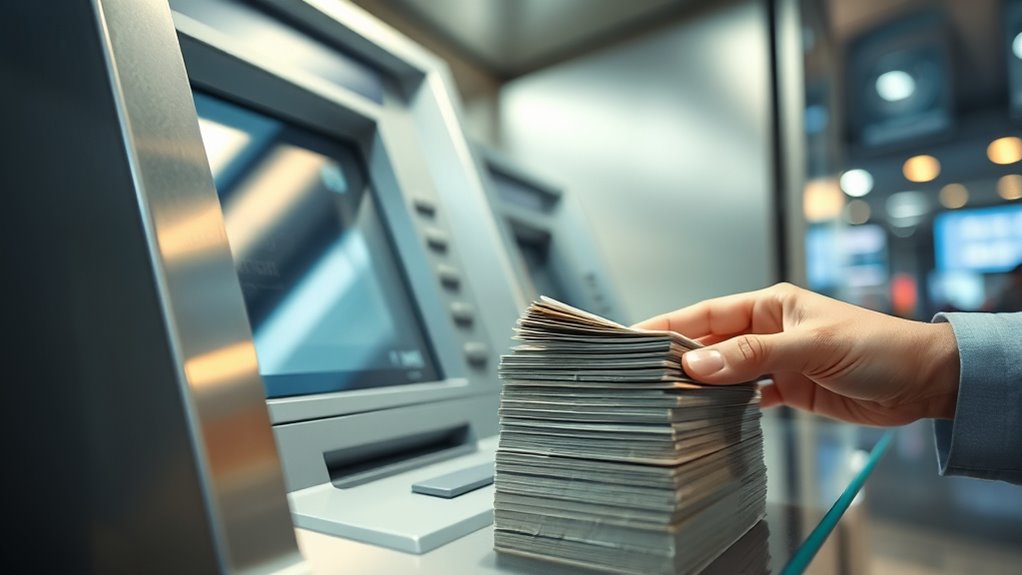
Managing cash effectively depends on your specific financial situation and goals. To handle different scenarios, consider these strategies:
- Maintain a solid emergency fund to cover unexpected expenses and ensure cash flow remains steady.
- Adjust cash on hand based on upcoming bills or planned purchases, avoiding unnecessary withdrawals.
- Keep extra cash during periods of irregular income to prevent cash flow issues.
- Use cash for budget-specific needs, like daily expenses, to better control spending and avoid debt.
When and Why to Use Cash Instead of Digital Payments
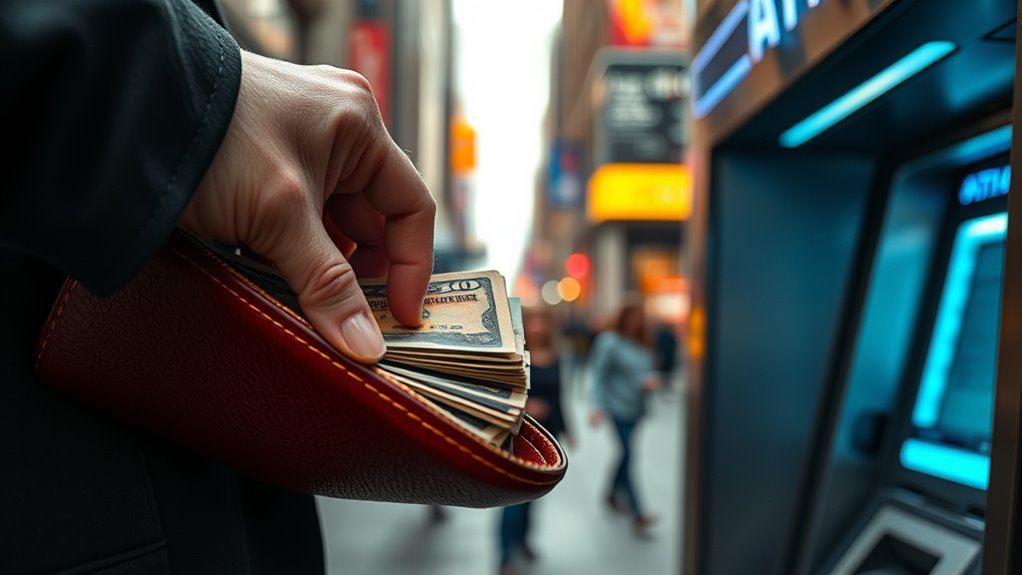
Despite the convenience of digital payments, there are times when cash is the smarter choice. For example, in areas with poor internet, cash guarantees you can still pay without relying on digital wallets or cryptocurrency security. Some merchants prefer cash, especially small vendors or markets. Also, cash offers privacy, reducing data exposure. Use cash during emergencies or when avoiding digital transaction fees. Here’s a quick comparison:
| Situation | Why Use Cash | When Digital Payments Help |
|---|---|---|
| Limited internet access | No reliance on connectivity | When online transactions are easy |
| Privacy concerns | Keeps your spending private | Digital wallets for quick pay |
| Security risks | No hacking risk with cash | Secure transactions with crypto |
| Small vendors | No card reader needed | Larger stores or online shopping |
Cash remains essential when security, privacy, or connectivity are concerns.
Best Practices for Storing and Handling Cash at Home
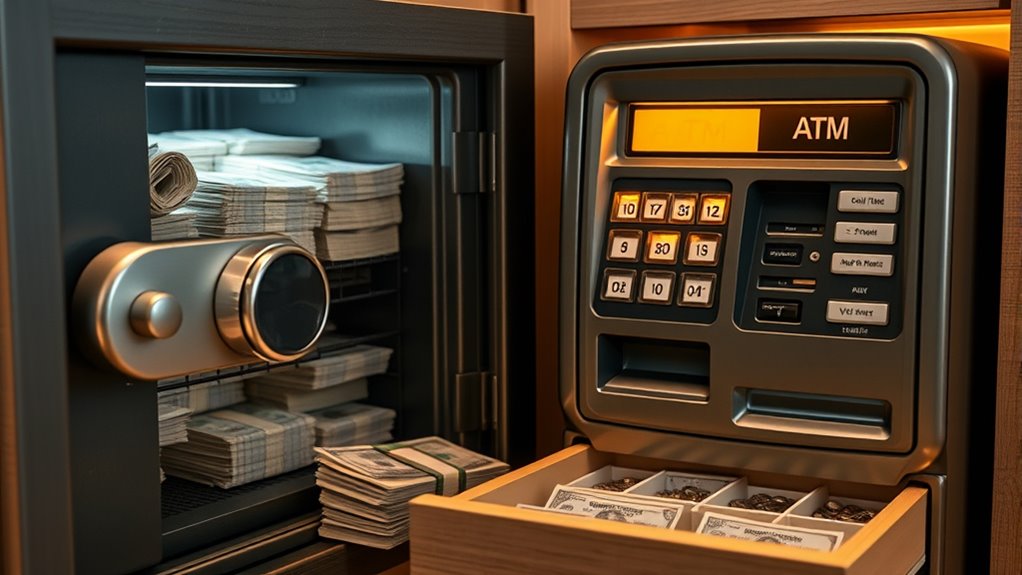
Storing cash at home requires careful planning to guarantee safety and accessibility. To optimize your cash storage, consider these security measures:
Store cash securely at home with discreet safes and regular safety reviews to protect your assets effectively.
- Use a discreet, locked safe in a hidden location.
- Avoid obvious spots like drawers or under mattresses.
- Limit the amount of cash stored at home to reduce risk.
- Regularly update and review your cash handling practices.
Implementing these steps safeguards your cash and makes handling it easier. Keep security measures consistent, and avoid sharing your storage plans. Remember, keeping cash in a secure, concealed spot minimizes theft and damage. Proper cash storage isn’t just about hiding money; it’s about protecting your assets while ensuring you can access funds quickly when needed. Stay vigilant, and make smart choices to keep your cash safe at home.
Frequently Asked Questions
How Much Cash Should I Keep on Hand Regularly?
You should keep enough cash on hand for daily expenses and minor emergencies, typically around $200 to $500. Good cash management means balancing accessibility with safety. Keep an emergency fund with three to six months’ worth of living expenses in a separate savings account, not just cash on hand. This ensures you’re prepared for bigger surprises without risking your cash being lost or stolen.
What Are the Signs of ATM Skimming Devices?
Imagine your ATM as a trusted friend’s house—would you notice if something looked off? Signs of skimming devices include loose or bulky card readers, unusual attachments, or scratched surfaces. For skimming detection, inspect the device closely for tampering or unfamiliar parts. Always check for hidden cameras or tiny holes. If anything looks suspicious during device inspection, avoid using that ATM and report it immediately.
Can I Withdraw Large Sums Without Notifying My Bank?
You can often withdraw large sums without notifying your bank, but it’s wise to verify your bank’s policies first. Keep in mind, making big bank withdrawals may raise privacy concerns, especially if you’re withdrawing in cash. To avoid issues, notify your bank beforehand to ensure smooth transactions and maintain your privacy. This way, you won’t face delays or suspicion during your bank withdrawal.
Are There Safer Ways to Carry Large Amounts of Cash?
Yes, there are safer ways to carry large amounts of cash. You should follow security tips like using discreet bags, avoiding obvious signs of wealth, and never flashing cash in public. Consider alternative methods such as bank transfers, cashier’s checks, or digital payments to reduce risk. These options help protect your money and minimize theft or loss, ensuring your funds stay secure during transactions.
How Do Currency Exchange Rates Affect Cash Withdrawals Abroad?
Did you know that currency exchange rates fluctuate up to 10% daily? When you withdraw cash abroad, these fluctuations impact how much local currency you get. If the foreign exchange rate shifts unfavorably, your money may buy less than expected. Staying aware of currency fluctuation trends helps you plan better, and using cards with low foreign transaction fees can minimize losses caused by exchange rate swings during your cash withdrawals.
Conclusion
Understanding cash on hand and ATMs isn’t just about convenience; it’s about security and smart management. While some believe digital payments will fully replace cash, history shows cash remains essential during emergencies and outages. By staying informed and cautious, you can handle your cash confidently, avoiding scams and fees. Remember, evidence suggests a balanced approach—using both cash and digital methods—best prepares you for any financial situation.
